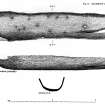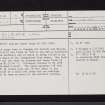Kilbirnie Loch
Logboat
Site Name Kilbirnie Loch
Classification Logboat
Alternative Name(s) Loch Of Kilbirnie; Kilbirnie Loch 3
Canmore ID 42222
Site Number NS35SW 8
NGR NS 3278 5373
Datum OSGB36 - NGR
Permalink http://canmore.org.uk/site/42222
- Council North Ayrshire
- Parish Kilbirnie
- Former Region Strathclyde
- Former District Cunninghame
- Former County Ayrshire
NS35SW 8 3278 5373
See also NS35SW 5 and NS35SW 11.
(NS 3278 5373) Dug-out Canoe found AD 1930 (NAT)
OS 6" map (1970)
A dug-out canoe (now in Glasgow Art Gallery and Museum, Acc. No.30-7) was found in 1930 in the mud in Kilbirnie Loch, the southwest end of which is being filled in by the slag heaps of the Glengarnock Iron
Works (L M Mann 1933). The find-spot was not far from the crannog and canoe finds of 1868 (see NS35SW 5). (Findspot located to NS 3278 5373 from Mann's plan). The canoe measures 11 1/2 feet long, 1ft 3 1/4 inches wide and 1 1/2 feet deep; it has been cut out of a solid oak trunk and axe markings can still be seen on parts of the exterior surface.
Visited by OS (JLD) 5 September 1956.
In April 1930 a further logboat was found about 410m NE of the findspots of the logboats NS35SW 5, and as a result of the same processes. It was buried in fine mud, probably after sinking in deep water.
When discovered, it measured about 11'6" (3.5m) in length over all and up to 1'11?" (0.6m) in breadth, and was 1'6" (0.5m) 'deep'. The marks of an 'axe' were noted and amidships there was a recess which was probably intended to receive a thwart. Two holes piercing the starboard quarter were identified as probably intended to retain a pair of rowlocks or thole-pins; there were no corresponding perforations in the port side.
Immediately after its discovery the surviving remains, which comprise the bottom and the lower parts of the sides and ends, were taken to the Glasgow Art Gallery and Museum where they are in store under accession number GAGM 30-7, having been bolted to a pallet which renders the bottom inaccessible. After shrinkage, the remains measure 3.1m in length by up to 0.71m transversely; the starboard side survives to a maximum height of 0.28m. Extensive flaking (which superficially resembles toolmarking) has occurred near the broader end, and the timber is greatly split and knotted.
The boat has been crudely constructed without the use of thickness-gauges and is noticeably assymetrical; the sides and the bottom measure about 30mm and between 30mm and 50mm in thickness respectively. Within what was probably the starboard side at a point 1.2m from the broader end (and some 66% of the length from the assumed bow) there is a possible support for a thwart in the form of a hollow measuring 80mm square and 20mm deep which is defined on three sides by a raised portion about 70mm thick left in the solid. Towards the broader end (at 69% and 76% respectively of the surviving length) there are two oval holes which measure 40mm by 20mm and are set 0.2m apart just below the top of the surviving side; their function is unclear and there is no comparable feature in the other side.
The boat has probably been worked from a whole section of log and the two extremities are badly damaged but appear to be of rounded form; the broader was more probably the stern. The McGrail morphology code is 222:112:222 and the shape is a variant of the canoe form.
L M Mann 1933; S McGrail 1987; R J C Mowat 1996, visited October 1987.












